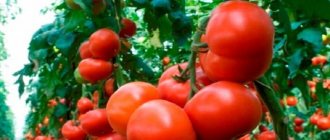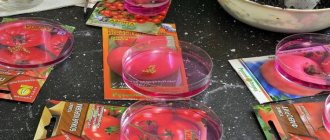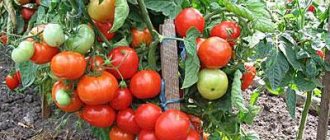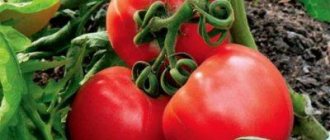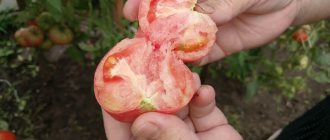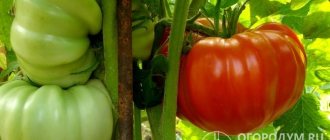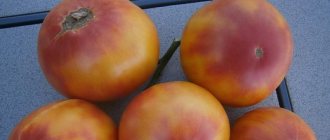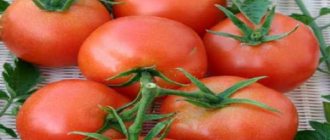| Ripening period: | average |
| Productivity: | 6-8 kg per 1 sq. m. |
| Regionality: | Siberia |
| Bush type: | determinant |
| Priming: | open |
Large-fruited tomatoes always attract the attention of summer residents. It is worth noting a variety of Russian origin - the sweet tomato Monomakh's Cap, which was created specifically for cold climates. The plant is suitable for growing without shelter, but also grows comfortably in greenhouse conditions. The advantages and features of the variety are worth considering in more detail.
Characteristics and description of the variety
The varietal tomato Monomakh's Cap, the description of which was registered in the State Register more than 15 years ago, is classified as indeterminate. The growth of the bush does not stop on its own and grows up to 1.5 m.
The growing region of the crop is officially considered to be Siberia, but tomatoes can also be planted in warmer areas. The variety tolerates not only cold temperatures, but also dry weather.
Monomakh's hat is characterized by:
- moderate density of shoots;
- dark green soft leaves of large size;
- growing season 90-110 days;
- simple inflorescences;
- articulated stalk.
Fruit
The appearance of Monomakh's Cap tomatoes is shown in the photo.
The main physical characteristics of the fruit can be described as follows:
- weight 0.4-0.6 kg;
- rounded, slightly flattened shape;
- red peel;
- dense juicy pulp;
- 6-8 seed chambers;
- weakly expressed ribbing.
Taste qualities
Monomakh Cap tomatoes have a pleasant taste, the basis of which is sweetness with a small amount of sourness. In combination with a rich aroma, the taste stands out even brighter. The tasting rating given by experts is 5 out of 5 among similar varieties.
Productivity
Productivity is the most important characteristic of varietal tomatoes. In good conditions, subject to the rules of agricultural technology, you can harvest 6-8 kg of tomatoes from one Monomakh Cap bush.
Based on the planting area, this value is 18-20 kg per square meter. When grown in greenhouses, the yield drops by 2-3 kg.
Usage
Based on experience, summer residents and experts define the use of Monomakh Cap tomatoes as universal.
Tomatoes are suitable for preparing salads and fresh dishes due to their dense, fleshy pulp.
When choosing canned food for processing, it is worth considering the size of the fruit, which can only be placed in jars in chopped form. The sweetness of tomatoes pairs well with other vegetables in stew mixtures.
Despite the large amount of dry matter, Monomakh's Cap is suitable for making juices, sauces and tomato paste.
Application
Thanks to the ideal combination of sugars and acids, Monomakh Cap tomatoes are perfect for making delicious juice and tomato paste.
They are very tasty, so they can be eaten fresh and added to salads. But such tomatoes are not suitable for whole canning due to their weight and size. But they can be used for winter preparations, to which processed tomatoes are added.
Watch the video! Tomato Monomakh's Cap
Growing seedlings
Tomato seeds are planted for seedlings in advance, based on climatic conditions. It is recommended to sow Monomakh Cap tomatoes in March or early April.
The preliminary preparation of seed material includes:
- Inspection and rejection of seeds with damage or defects.
- Germination test. To do this, the seeds are immersed in a solution of table salt for 5-10 minutes. Empty husks that have not sunk to the bottom are unsuitable for planting.
- Disinfection in a weak solution of potassium permanganate for 20-30 minutes.
Seed germination is allowed for 48 hours in a damp cloth at a temperature of 27°C.
Low containers for seedlings are disinfected in advance and equipped with drainage. The containers are filled with universal soil for seedlings or a hand-made soil mixture. It is important to choose the right ingredients in order to obtain a light and nutritious environment, as well as to facilitate the care of seedlings.
The seeds are placed no closer than 3 cm from each other to a depth of 1-2 cm. A thin layer of peat or soil can be poured on top. The first watering should not erode the soil, so it is recommended to use a spray bottle.
The container is covered with transparent material on top and then placed on the windowsill. The air temperature for rapid emergence of seedlings should be 24°C.
After the third leaf appears, the seedlings should be transplanted into separate containers. In this case, weak and non-viable shoots can be removed. After 10 days, the seedlings must be fed with a nitrogen-based complex fertilizer.
14 days before moving to a permanent location, plants should be hardened off in the fresh air.
Landing in the ground
The seedlings are ready for planting 60 days after sowing the seeds. It is important to plant plants in a permanent place when the air is warmed up and the average temperature has stabilized at 16°C.
The area for tomatoes should first be dug up, fertilized and acidity neutralized. The beds are formed in the direction from north to south.
The distance between the rows should be at least 0.6 m. It is better to place the plants at a distance of 0.5 m so that the bushes do not take away sunlight from each other. The depth of the holes is no more than 0.2 m, the stem should not be in the ground.
You should not plant more than 4 bushes on each square meter.
It is recommended to plant in cloudy weather, or in the evening, when the soil will not dry out under direct sunlight. Plants need to be watered immediately after planting.
In the next 7-10 days, the tomatoes should not be disturbed; the bushes should get used to their permanent location.
Planting seedlings and caring for them
Tomatoes do not like soil that has acidic properties - if they are planted in such soil, the bushes will wither. To reduce acidity, fluff lime and dolomite flour are poured into the ground when digging. Seedlings are planted in the ground before flowering.
When planting seedlings, dig holes, making a space of 50 cm between holes, and 60 cm between rows. Plant up to 6 plants per 1 m².
When the tomatoes in the upper clusters become full and weigh 100 g, feed the bushes with potassium nitrate. With this feeding, the tomatoes will not get blossom end rot and will not crack.
Weed control
Don't pull out the weeds - just cut them with a flat cutter several times over time and let the roots rot in the ground. Place weed clippings between the rows. It is recommended to put earthworms in the mulch and cover them with chopped grass on top.
You cannot water this variety along the furrows you have made. Tomatoes love water very much, so water the bushes very generously at the roots, so that the water penetrates two shovels deep into the ground. Then you will get a big harvest.
Removing stepsons, barren flowers, pinching
Be sure to cut off the stepsons. Each sprout usually grows 3 trunks, tear off two of them. After planting the seedlings, tie up each bush.
To form a harvest, remove small flowers; when flowering, shake the plant so that it is pollinated. If you planted tomatoes in a greenhouse, do not forget to ventilate the room. After pollination, water the bushes, then the pollen will germinate.
The first bud that opens is always terry and must be picked. Leave 2 ovaries on the first brush, tear off the rest.
Since the plant is classified as an indeterminate variety, the bush does not stop growing upward, as a result, there will be ovaries on the bush in late autumn. The bushes grow tall and grow very quickly. When the plants are 1 m tall, pinch the tops off.
If, due to autumn rainy weather, you are forced to collect tomatoes ahead of time, then collect the brownish fruits - they have a good taste, and if you leave the tomatoes in the rain, the fruits will begin to crack.
Read also: Gooseberry variety Komandor (Vladil): photos, reviews, description, characteristics
Features of care
The Monomakh Cap tomato variety needs careful care for high yields. As the bushes grow and gain green mass, they require support, which can be installed immediately after transplanting the seedlings.
It is important not only to securely fasten the stem, but also to fix the shoots with heavy bunches of tomatoes.
In addition, for quality care of the variety you need:
- regular watering;
- weeding;
- fertilization;
- stepsoning;
- pest control treatment;
- prevention of fungal infections.
Watering
Proper organization of watering is important not only for the growth of bushes, but also for the filling of tomatoes. The variety requires a lot of water, so it is better to replace watering in furrows with abundant moisture of the soil at the roots.
For deeper penetration of the liquid, the soil should be loosened, but not too actively, so as not to damage the thin roots.
Mulching the beds with dry grass, straw or sawdust helps retain moisture. This procedure prevents the abundant growth of weeds.
The rate of watering depends on the weather, but since the variety tolerates drought well, it is enough to moisten the soil up to 3 times a week. The main condition is that the water must be warm and well-settled. On rainy days, tomatoes do not need additional watering.
Stepsoning
The description of the Monomakh Cap variety and reviews from gardeners claim that the yield of these tomatoes increases significantly with regular removal of the stepsons. The tendency for increased growth of dock shoots leads to thickening of the bush and a decrease in productivity.
All shoots that appear in the leaf axils must be cut off at a level of 1-2 cm from the base. You should not break out the shoots, as this may damage the main shoot.
Bush formation
Intensive growth of green mass is characteristic of indeterminate varieties. At the very beginning of growth, the Monomakh Cap tomato bush is prone to thickening. Without formation, a tomato grows by producing up to 3 main stems. It is important to remove excess shoots in a timely manner so that the plant has only one trunk.
When the central shoot reaches 1-1.2 m, the top needs to be pinched to limit the height of the bush.
The variety is grown in open ground, so there are no difficulties with natural pollination. But there is a problem with the appearance of an excessive number of ovaries. It is recommended to remove the first bud in the inflorescence, as well as small or deformed flowers. To obtain large tomatoes, it is better to leave 1-3 healthy ovaries in the bunch.
Fertilizers
The productivity of Monomakh's Cap is affected by regular fertilizing. Watering plants with the addition of fertilizer is carried out at least three times during the entire growing season:
- during flowering;
- during the formation of ovaries;
- at the beginning of fruiting.
Flowering takes away a lot of nutrients from tomatoes, so to stimulate the appearance of buds it is worth adding a complex fertilizer, the main component of which should be phosphorus.
When setting tomatoes, plants need organic fertilizers. You can use an aqueous solution of bird droppings in a ratio of 1 to 15. In general, when growing vegetable crops, you should alternate mineral fertilizers and organic matter. At the beginning of fruiting, complex fertilizing is usually used, in which potassium compounds play a dominant role.
Monomakh's Cap: a famous salad tomato variety
Gardeners especially value those tomatoes that have an optimal balance between ripening time, difficulty of care and yield. These characteristics are successfully combined in the Monomakh Cap variety. It is not particularly whimsical, ripens in an average period, and you can make a salad from it using just one fruit.
Varieties Monomakh's Cap: characteristics
Monomakh's Cap is a medium-ripening salad tomato. The first tomatoes reach ripeness 110–115 days after sprouting. Suitable for cultivation in all regions of the country. Can be cultivated both in protected and open ground. The yield of the variety is on average 7.1 kg/m2. Year of registration in the State Register: 2007.
Description of the appearance of bushes and fruits
The Monomakh Cap tomato forms a determinate bush up to 1–1.5 m high. Large leaves are dark green in color. The ovaries are formed in a simple inflorescence.
The fruits of this variety are large in size and flat-round in shape with slight ribbing on the sides. The average weight of each is 264 g. The largest tomatoes grow on the first bunch - their weight can reach 400-500 g, rarely - 1 kg. When unripe, tomatoes are green in color, and when ripe they become crimson. The outside of the fruit is covered with thin skin. There are at least 4 seed chambers inside. The pulp is sweet, fleshy.
The fruits of the Monomakh's Cap tomato are large in size and crimson in color.
Features of tomato, varietal advantages and disadvantages
The benefits of the Monomakh Cap tomato include:
- good taste;
- a small amount of seeds inside;
- resistance to temperature fluctuations;
- good resistance to crown and root rot, powdery mildew and verticillium;
- the possibility of using collected seeds for sowing in the future.
The main disadvantages of the variety are:
- the tendency of fruits to crack (with excessive moisture in the beds);
- tomatoes do not tolerate transportation well (during it they wrinkle and crack);
- poor keeping quality (ripe tomatoes spoil quickly).
Unlike other determinate salad varieties, the Monomakh Cap tomato has a relatively low yield. It forms a small number of ovaries (about 3–5), but this is compensated by the massiveness of the fruits. The variety is not suitable for commercial cultivation.
Table: comparison of the Monomakh Hat tomato with other similar varieties
| Variety name | Ripening time | Purpose | Approximate fruit weight (g) | Marketable yield (kg/m2) | Cultivation region | Growing conditions |
| Monomakh's hat | Mid-season. | Salad. | 264 | 7,1 | All. |
|
| Mazarin | Early ripening. | Universal. | 150–190 | 13,5–14 | ||
| St. Andrew's surprise | Late ripening. | Salad. | 150–230 | 8 | ||
| Bull's heart | Medium late. | 108–225 | 3–4 | |||
| Cardinal | 442 | 7,2–8,4 | Film shelters. | |||
| Bear Paw | Mid-season. | 115–300 | 7,1 | Open beds. |
Features of growing and planting tomato Monomakh's Cap
The greatest return on yield occurs if no more than 3 tomato bushes are planted per 1 m2 according to the pattern 50x60 or 60x60 cm. Plants should be formed into 2 stems. They require tying to a trellis and regular removal of stepsons. Experienced gardeners have also noticed that if you leave no more than 2-3 ovaries in the clusters, the fruits will be approximately the same size and more neat in shape.
Basic care consists of watering, loosening the soil and hilling the bush. The variety is responsive to fertilizer application. Tomatoes are not particularly resistant to late blight, so they will benefit from preventive treatment with fungicides (Fundazol, Topaz).
Video: why and how to form tomatoes correctly
baznata
https://www.nn.ru/community/dom/dacha/kakie_pomidory_my_sazhaem.html
Foxi1502
https://irecommend.ru/content/u-kogo-net-v-kollektsii-takogo-zamechatelnogo-sorta-ne-razdumyvaya-priobretaite
Video: review of tomato variety Shapka Monomakh
The Monomakh Cap tomato is a tasty variety that should go straight from the garden to the table. It can be grown in the south of the country, in the middle zone, and even in risky farming areas. However, in regions with short and cool summers, it is better to keep plants in a greenhouse or greenhouse. Then the fruit size will be large and the yield will increase.
Diseases and pests
Varietal tomatoes Monomakh's Cap are characterized by a high degree of resistance to nightshade diseases. Preliminary disinfection of planting material will help avoid late blight and other fungal infections.
Tomatoes of this variety are prone to fruit cracking, especially when grown in greenhouse conditions. The problem is affected by irregular or excessive watering, stagnation of air or lack of nutrients in the soil.
Growing tomatoes in open ground worsens the impact of pests on the future harvest. Insects move freely around the site and can cause serious damage to vegetables. The danger to culture is:
- Wireworm. The pest can be eliminated using bait, removed manually, or using industrial insecticides.
- Mite. Insect repellents or infusion of onion peels work well against the pest.
Advantages and disadvantages of the variety
The main advantages of Monomakh's Cap tomatoes:
- large fruit;
- sweet rich taste;
- frost resistance;
- extensive growing region;
- immunity to diseases;
- simultaneous ripening of tomatoes.
The variety has not only advantages, but also some disadvantages:
- weak stems and shoots;
- the need for stepsoning;
- indeterminateness;
- tendency to crack the skin.
A few reviews about the variety
Elina S., 48 years old, Angarsk:
“My husband has been planting tomatoes of the Monomakh Hat variety for 3 years in a row. I found that I grew the most fruits at almost the same temperatures day and night. That year, when the summer was warm, we collected 5 kg of fruit from each bush. They make excellent salads and sauces, as the tomatoes are sweet and juicy. Be sure to remove the stepsons when growing.”
Polina A., 24 years old, Volgograd:
Until recently, we grew Sugar Giant and Grandma's Secret tomatoes. But a neighbor gave us the seeds of the Monomakh's Cap tomato, and I planted it. I would like to give advice to those who have not yet grown this variety: pick off the stepsons when the bushes are still very small. In addition, tomatoes have a lot of empty flowers, I select them and pick them off. Usually the largest tomatoes grow on the first lower cluster. The fruits themselves are sugary and tender. They have thin skin that can crack. The weight of each tomato is 360 - 600 g. I have never grown larger fruits. Bushes up to 1.2 - 1.3 m in height.
Reviews about tomatoes are positive; all gardeners really like large, sweet and sour tomatoes; a large number of fruits are collected from the bushes. The variety is resistant to common tomato diseases.
